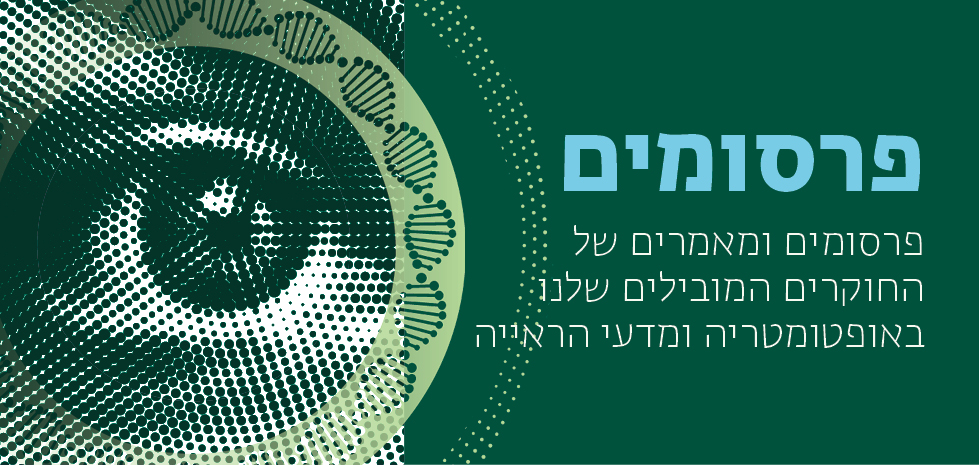ספרים ומאמרים

-

What Factors Affect Binocular Summation?
תקצירBinocular vision may serve as a good model for research on awareness. Binocular summation (BS) can be defined as the superiority of binocular over monocular visual performance. Early studies of BS found an improvement of a factor of about 1.4 (empirically), leading to models suggesting a quadratic summation of the two monocular inputs (√2). Neural interaction modulates a target's visibility within the same eye or between eyes (facilitation or suppression). Recent results indicated that at a closely flanked stimulus, BS is characterized by instability; it relies on the specific order in which the stimulus condition is displayed. Otherwise, BS is stable. These results were revealed in experiments where the tested eye was open, whereas the other eye was occluded (mono-optic glasses, blocked presentation); thus, the participants were aware of the tested eye. Therefore, in this study, we repeated the same experiments but utilized stereoscopic glasses (intermixed at random presentation) to control the monocular and binocular vision, thus potentially eliminating awareness of the tested condition. The stimuli consisted of a central vertically oriented Gabor target and high-contrast Gabor flankers positioned in two configurations (orthogonal or collinear) with target-flanker separations of either two or three wavelengths (λ), presented at four different presentation times (40, 80, 120, and 200 ms). The results indicate that when utilizing stereoscopic glasses and mixing the testing conditions, the BS is normal, raising the possibility that awareness may be involved.
-

Optogenetics-integrated gut organ culture system connects enteric neurons dynamics and gut homeostasis
תקצירThe enteric nervous system (ENS) senses microbiota-derived signals and orchestrates mucosal immunity and epithelial barrier functions. However, mechanistic dissections of intestinal neuro-immune-microbiota communications remain challenging. Here, we present an optogenetics-integrated gut organ culture system that enables real-time, whole-tissue stimulation of defined ENS lineages, and detailed analysis of their functional impact. We demonstrate that optogenetic activation of enteric cholinergic neurons rapidly modulates intestinal physiology. Interestingly, distinct neuronal firing patterns differentially modulate neuro-immunological gene expression and epithelial barrier integrity. Furthermore, diverse enteric neuronal lineages exert distinct regulatory roles. While cholinergic activation enhances gene-sets associated with type-2 immunity, tachykininergic neurons modulate distinct mucosal defense programs. Intriguingly, luminal introduction of the immunomodulatory bacterium Thomasclavelia ramosa remodeled cholinergic-induced neuro-immunological transcription. These findings suggest that microbial and neuronal signals are locally integrated to fine-tune gut immunity and barrier defense. Collectively, we provide a powerful platform for systematic discovery and mechanistic exploration of functional neuroimmune connections, and their potential modulation by microbes, drugs or metabolites.
-

Oculomotor chronometry of spoken word structure processing
תקצירOculomotor inhibition (OMI) is the momentary inhibition of involuntary eye movements, such as saccades and blinks, following sensory stimulation. Higher-level cognitive processes, such as processing the structure of written words, have been shown to affect the duration and magnitude of the OMI. In this study we tested whether OMI measures are influenced by the processing of spoken word structures. Participants listened to Hebrew words and pseudowords presented auditorily while we recorded their microsaccades, eye blinks, and pupil dilation. Spoken pseudowords were divided into two groups based on their underlying linguistic structure, with one half containing real roots and the other half containing invented roots. Results show a greater OMI for Real-root pseudowords as compared to Invented-root pseudowords, replicating the morpheme interference effect found previously for written stimuli. OMI measures, including microsaccade and eye blink latencies, as well as pupil dilation peak latency, were consistently greater for real-root pseudowords compared to invented-root pseudowords. These findings demonstrate the sensitivity of OMI to the cognitive processing of spoken word structure, even in the absence of visual stimuli or visually directed task. The results highlight the potential role of oculomotor responses as a marker of higher-order linguistic processing.
-

Children with Autism Show Impaired Oculomotor Entrainment to Predictable Stimuli
תקצירIndividuals with Autism Spectrum Disorder (ASD) show altered synchronization with external events, which may underlie the rigidity and reduced adaptability that characterize the condition. We previously demonstrated that electroencephalography (EEG) recorded from children with ASD reveals impaired neuronal entrainment to predictable visual sequences. Whether similar effects are reflected in other physiological signals remains unclear. Here, we investigated whether eye movement and pupil dilation responses exhibit comparable entrainment differences in ASD. Microsaccades (MS) and pupil diameter were recorded from 31 children with ASD (6-9 years) and 21 age- and IQ-matched typically developing (TD) controls during a task in which four equally spaced visual cues preceded an auditory target. We analyzed modulation of MS release time (MS RT) and pupil response time (pupil RT), along with trial-by-trial variability, as indices of ocular entrainment. Both groups exhibited periodic oculomotor responses to the cues, including phasic MS inhibition and repeated pupil constrictions. In TD children, MS RT and pupil RT increased across cues while their variability decreased, consistent with progressive temporal alignment. These effects were significantly reduced in the ASD group. Oculomotor entrainment measures correlated with EEG inter-trial phase coherence (ITPC) in TD but not ASD children. They also correlated with behavioral response times in both groups, and moderately correlated with autism severity scores. Children with ASD thus showed diminished oculomotor modulation and greater variability in response to predictable stimuli, paralleling earlier EEG findings. These results suggest convergence across physiological systems in indexing impaired processing of predictability in ASD and highlight the promise of multimodal approaches.
-

Oculomotor-Related Measures Are Predictive of Reading Acquisition in First Grade Early Readers
תקצירSome estimates suggest that one in seven good readers and the majority of children with reading difficulties suffer from oculomotor dysfunction (OMD), an umbrella term for abnormalities in comfortable and accurate fixations, pursuits, and saccades. However, national vision evaluation programs worldwide are often limited to distance visual acuity (dVA), not testing for OMD despite its high prevalence and the ease of detecting it in brief optometric evaluations. We hypothesized that reading acquisition is dependent on good oculomotor functions, and therefore inadequate oculomotor control will be associated with reading difficulties. We retrospectively examined and compared oculomotor evaluations (using DEM and NSUCO) and reading assessments (using standardized national reading norms) of a normative class (28 first graders (6-7 yr. olds)) that were independently obtained while blind to the other assessment. Better oculomotor performance as estimated by DEM was associated with better reading performance, and almost a third (29.6%) of the children were categorized by DEM as having OMD-related difficulties. Control analysis revealed dVA was not positively associated with reading performance. Linear regression analyses further corroborated these findings. Since this study is based on a small cohort and since there are studies suggesting that DEM may actually reflect visual processing speed or cognitive factors rather than oculomotor function, replications are needed to substantiate the direct contribution of oculomotor functions to reading acquisition. Young children struggling with reading may benefit from a comprehensive visual evaluation, including oculomotor testing, to provide a more thorough assessment of their learning-related difficulties.
-

Reactivity of the Autonomic Nervous System During Visual-Physical Incongruent Walking Conditions-A Virtual Reality Study
תקצירThe force of gravity critically impacts locomotion regulation while walking on inclined surfaces. To construct an updated assessment about the gravitational consequences and change gait patterns accordingly, the central nervous system (CNS) integrates multiple sensorial cues, including vestibular and proprioceptive (i.e., body-based cues) and visual. Not much is known about the contribution of the autonomic nervous system (ANS) to locomotion regulation, especially when multiple types of sensorial cues are involved. Here we examine the responsiveness of the ANS, as reflected by cardiac reactivity, for example heart rate (HR) and heart rate variability (HRV), to coherent versus non-coherent sensorimotor signaling. Fourteen healthy young participants completed level, uphill, and downhill self-paced walking trials in a virtual reality (VR) environment in which the incline of the visual scene was either congruent or incongruent with the physical incline of the walking surface. We found that during level walking, incongruent visual cues (i.e., up/downhill scenery) triggered alterations in ANS balance, reflected in HRV decrease and in a residual increase of HR. Taken together with the fact that an ultimate change in gait patterns requires alterations in cardiac resources, we speculate that ANS function and its responsive modes of action are, in fact, facilitating adaptive behavior.
-

Foveal crowding modifies a target's properties under a brief presentation time
תקצירThe perception of chromatic and achromatic visual information is combined and processed in the parvocellular stream; however, they are separate processes at the early stage of the visual cortex. In our previous study, we noted that there is difficulty discriminating the color of a letter target presented at the fovea under a crowded presentation for a short time. Visual crowding occurs when an easily identified isolated stimulus becomes very difficult to identify when it is surrounded by stimuli with similar properties. One opinion is that crowding reduces the ability to identify the target but not its features (e.g., color and texture); however, some studies indicated that the ability to recognize features is also impaired under peripheral crowding conditions. Here, we investigated whether the processing of chromatic information can be impaired at the fovea using a classic crowding experiment when tested at brief presentation times (20, 40, and 120 ms). The participants reported both the target's identity and chromaticity (dual task). We found that the target's identification and color discrimination are impaired when presented for 20-40 ms but that they recover for longer presentation times. This effect is increased when temporal backward masking is added. This finding suggests that crowding resembles masking under brief presentation times and occurs at a later processing stage, after an initial masking stage.
-

The canonical deep neural network as a model for human symmetry processing
תקצירA key property of our environment is the mirror symmetry of many objects, although symmetry is an abstract global property with no definable shape template, making symmetry identification a challenge for standard template-matching algorithms. We therefore ask whether Deep Neural Networks (DNNs) trained on typical natural environmental images develop a selectivity for symmetry similar to that of the human brain. We tested a DNN trained on such typical natural images with object-free random-dot images of 1, 2, and 4 symmetry axes. Symmetry coding was negligible in the earliest DNN layers. The strongest discriminability occurred in the first fully connected layer, FC6, plausibly analogous to the human lateral occipital complex (LOC), matching many structural properties of human symmetry processing. These results support the homology between the feedforward DNN trained on natural images and the global processing of the extended visual hierarchy as it has evolved in the human brain.
-

The effect of virtual visual scene inclination transitions on gait modulation in healthy older versus young adults-A virtual reality study
תקצירBipedal locomotion requires body adaptation to maintain stability after encountering a transition to incline walking. A major part of this adaptation is reflected by adjusting walking speed. When transitioning to uphill walking, people exert more energy to counteract gravitational forces pulling them backward, while when transitioning to downhill walking people break to avoid uncontrolled acceleration. These behaviors are affected by body-based (proprioception and vestibular) cues as well as by visual cues. Since older age adversely affects walking, it is unclear whether older adults rely on vision during locomotion in a similar manner to younger individuals. In this study, we tested whether the influence of visual cues on these walking speed modulations in healthy older adults (60-75 years old, N = 15) were comparable to those found in healthy young adults (20-40 years old, N = 12). Using a fully immersive virtual-reality system embedded with a self-paced treadmill and projected visual scene, we manipulated the inclinations of both the treadmill and the visual scene in an independent manner, and measured participants walking speed. In addition, we also measured individual visual field dependency using the rod and frame test. The older adults presented the expected braking (decelerating) and exertion (accelerating) effects, in response to downhill and uphill visual illusions, respectively, in a similar manner to the young group. Furthermore, we found a significant correlation between the magnitude of walking speed modulation and visual field dependency in each of the groups with significantly higher visual field dependency in older adults. These results suggest that with aging individuals maintain their reliance on the visual system to modulate their gait in accordance with surface inclination in a manner similar to that of younger adults.
-

The effect of virtual visual scene inclination transitions on gait modulation in healthy older versus young adults-A virtual reality study
תקצירBipedal locomotion requires body adaptation to maintain stability after encountering a transition to incline walking. A major part of this adaptation is reflected by adjusting walking speed. When transitioning to uphill walking, people exert more energy to counteract gravitational forces pulling them backward, while when transitioning to downhill walking people break to avoid uncontrolled acceleration. These behaviors are affected by body-based (proprioception and vestibular) cues as well as by visual cues. Since older age adversely affects walking, it is unclear whether older adults rely on vision during locomotion in a similar manner to younger individuals. In this study, we tested whether the influence of visual cues on these walking speed modulations in healthy older adults (60-75 years old, N = 15) were comparable to those found in healthy young adults (20-40 years old, N = 12). Using a fully immersive virtual-reality system embedded with a self-paced treadmill and projected visual scene, we manipulated the inclinations of both the treadmill and the visual scene in an independent manner, and measured participants walking speed. In addition, we also measured individual visual field dependency using the rod and frame test. The older adults presented the expected braking (decelerating) and exertion (accelerating) effects, in response to downhill and uphill visual illusions, respectively, in a similar manner to the young group. Furthermore, we found a significant correlation between the magnitude of walking speed modulation and visual field dependency in each of the groups with significantly higher visual field dependency in older adults. These results suggest that with aging individuals maintain their reliance on the visual system to modulate their gait in accordance with surface inclination in a manner similar to that of younger adults.
Copyright: © 2024 Benady et al. This is an open access article distributed under the terms of the Creative Commons Attribution License, which permits unrestricted use, distribution, and reproduction in any medium, provided the original author and source are credited.



